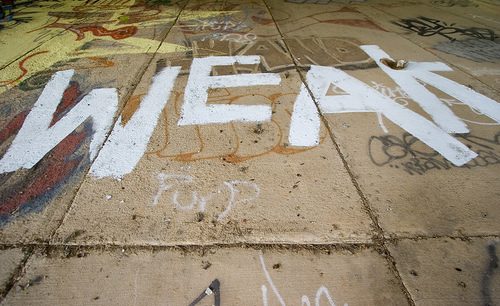Teaching writing through weakness

I’m a big fan of the building-on-your-strengths school of thought. I can expend energy trying to be someone I’m not (e.g., a humorist), or I can put that energy to work in a direction that’s natural for me. But when it comes to teaching writing, sometimes the educator’s greatest asset can be his or her own insecurities.
Recently I gave a talk for a group of pre-service teachers taking a course in writing instruction. My biggest message to them was to be real with their students when it comes to writing. I asked the future teachers how many of them felt challenged or frustrated by writing–at least some of the time. When hands went up, I promised them that this was a good thing.
Make mistakes and let your students see the mistakes. The job of the writing teacher is not to teach students a particular “proper” form of writing but to help them find their process to do many kinds of writing. This can only happen when teachers present themselves as students of writing as well.
I don’t know about you, but as a beginning tennis player, I’d much rather practice with someone who’s got tricks I don’t know but who is still learning as well. The same goes for students. It’s time to ditch the notion of the teacher as “pro” and start thinking of the teacher as a partner who can still miss some serves.
And it’s critical for students to see that–in writing–sometimes what seemed to be missed serves can turn out to be aces. I often show students how writing that I thought was “trash” had the seeds to important scenes in my novels.
Now, nothing is scarier than being vulnerable with students, especially when teaching older kids (or, worse, teachers themselves!). But this is critical if we want the writers we’re working with to take risks and to do writing that actually matters. Until students see the teacher as a fellow writer and learner, they will simply write to fulfill requirements and see that teacher as an arbitrary judge of a product that they (the students) don’t really care much about anyway.
When teachers also engage in the writing process and share the imperfect work that they are doing, students become willing to invest in their writing.
P.S. The idea of showing weakness and talking through how we deal with challenge applies in other spheres, too. As Liam has just turned one, we are realizing that one of the best ways we can help him deal with challenges and struggles (mostly related to self-control) is to model outloud our own dealings with frustration. Arnulfo and I walk around saying things like, “Darn it, I can’t find my keys. It’s so frustrating when this happens. I really want to get mad, but I think it will be easier for me to solve this problem if I stay calm. Hmmm, what can I do to change what’s bothering me. I know, I’ll ask for help…” This is pretty dorky, but I hope it will be effective eventually.




